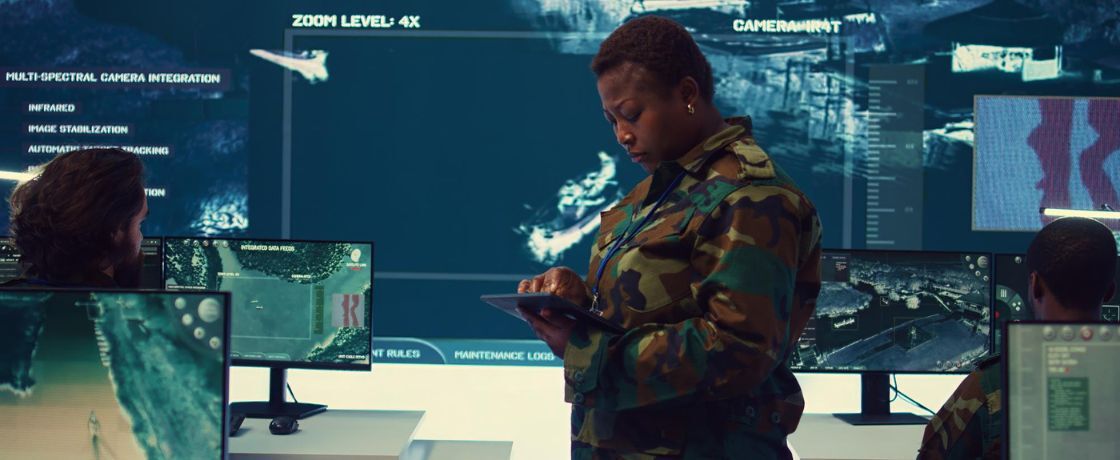Lowpass filters might not be grand or flashy, but they immensely impact many ground-breaking...
Passive vs. Active Band Stop Filters: Key Differences and Applications

In modern aerospace and defense (A&D) platforms, whether it's on the ground, in flight, or in orbit, electromagnetic interference (EMI) isn't just a nuisance - it can put critical functions in jeopardy. EMI can disable guidance systems, corrupt mission-critical telemetry, or even compromise battlefield situational awareness. While standard filtering techniques can suppress broad-spectrum noise, they often fall short against in-band interference caused by clock harmonics, hostile jammers, or closely packed multi-system platforms.
In these scenarios, LC band stop filters provide a critical solution. By precisely rejecting specific frequencies without degrading adjacent signals, they help preserve signal integrity and ensure mission performance. These filters are especially valuable when traditional broad-spectrum approaches are too blunt for the job.
LC band stop filters come in two main topologies: passive and active. Each presents unique benefits and trade-offs depending on environmental exposure, power constraints, and the mission profile.
This article explores how each architecture works, when to use them, and how to evaluate their effectiveness for high-reliability RF applications.
What are Band Stop Filters?
Band stop filters attenuate signals within a specific frequency band while allowing others to pass. Unlike low pass or high pass filters (which target the spectrum’s edges), band stop filters eliminate mid-band interference which is often centered around a single, problematic source.In LC-based implementations, these filters use inductor-capacitor networks where low pass and high pass sections are configured in parallel, producing a resonance that blocks a defined frequency band. This makes them highly effective in applications such as satellite payloads, military radios, and ground-based radar systems where targeted interface suppression is essential.
There are two main types:
- Notch filters (narrowband) are ideal for eliminating discrete interference, such as jammers operating near a known communication frequency. For instance, in an airborne tactical radio, a notch filter might suppress a specific harmonic generated by onboard computing systems without affecting adjacent mission-critical channels.
- Broadband reject filters are used when entire frequency bands must be removed. Take low Earth orbit satellites as an example; here, wideband EMI from onboard payloads must be prevented from leaking into adjacent RF chains or interfering with earth-ground downlink reception.

LC Bandpass vs. Band Stop Filter Circuits via Electrical Academia
In these cases, careful tuning is required to avoid compromising operational bandwidth while maintaining compliance with stringent military EMI standards like MIL-STD-461, which defines the EMI and electromagnetic compatibility (EMC) requirements for electronic systems used in military environments. It ensures that equipment neither emits excessive interference nor is overly susceptible to it. This is critical in A&D systems where dozens of subsystems operate simultaneously within tight proximity.
Band stop filters, when properly designed, help meet these thresholds by eliminating problematic frequencies that could potentially cause cross-system disruption or mission failure.
Passive LC Band Stop Filters
Passive LC band stop filters use only inductors and capacitors to reject specific frequencies, making them highly efficient and power-free. They’re ideal for space, airborne, or embedded defense systems where power is limited and reliability is crucial. These filters offer low insertion loss, excellent thermal stability, and natural resistance to radiation which are key advantages for satellites, UAV payloads, and long-duration missions.
Their simplicity, however, comes with its own set of constraints. This filter’s bandwidth and selectivity are set by component tolerances which offer little room for tuning. Over time, aging or thermal cycling can slightly shift the resonant points which may affect performance if not accounted for in design margins.
At lower frequencies, passive filters can become physically large due to the size of required inductors, potentially limiting their use in tightly packed systems. Still, for fixed-frequency, high-reliability applications, passive filters remain the most robust and Size, Weight, and Power (SWaP)-efficient solution.
Active LC Band Stop Filters
Active LC band stop filters combine LC networks with amplifiers or transistors to improve performance and add flexibility. They enable sharper roll-off, tunable bandwidth, and even gain in the passbands which are ideal for applications like electronic warfare, software-defined radios, or frequency-agile systems. This makes them well suited for dynamic or contested RF environments.
Their main benefit is adaptability. Filters can adjust in real time to suppress new threats or interference sources, which is critical in systems like ground-based radar, mobile comms nodes, or tactical EW suites. By integrating signal conditioning and reconfigurable filtering in one stage, active filters streamline complex RF chains.
The trade-offs include a reliance on clean, stable power, along with reduced tolerance to radiation and temperature shifts. Without proper mitigation, these vulnerabilities can compromise performance, especially in harsh or remote environments, making active filters better suited for ground, lab, or shielded platform use.
How to Choose Between an Active and Passive Band Stop Filter
Choosing between a passive and active band stop filter depends on the system’s environment, performance goals, and design considerations. While both filter types serve the same core function (removing unwanted frequencies), their behavior, complexity, and suitability can differ significantly.
The comparison table below highlights the key differences to help guide filter selection in aerospace and defense applications.
|
Parameter |
Passive LC Band Stop Filter |
Active LC Band Stop Filter |
|
Power Supply Dependency |
None |
Requires external power supply |
|
Q-Factor Control |
Fixed, depends on inductor/capacitor quality |
Tunable through active circuitry |
|
Stopband Depth (Attenuation in dB) |
Moderate to high (typically 20–60 dB) |
Can achieve high attenuation with proper design |
|
Environmental Robustness |
High (no semiconductors; better tolerance to radiation, vibration) |
Lower (sensitive to temperature, radiation, and mechanical stress) |
|
Component Footprint |
Compact at high frequencies, but inductor size may increase significantly at lower frequencies |
Larger due to active devices and power circuitry |
|
Insertion Loss in Passbands |
Low |
Higher, due to amplifier and active stages |
|
Noise Figure Contribution |
None |
Adds noise depending on active component design |
|
Suitability for Space-Qualified Designs |
Excellent; commonly used in high-reliability systems |
Limited; requires radiation-hardened components |
Choosing the right filter topology should align with SWaP constraints, interference profiles, and lifecycle requirements. Compact, lightweight, and energy efficient components are essential to maximize payload capacity and mission duration. Filters must not only perform well but also meet these physical and power limitations.
Interference profiles refer to the type, frequency, and behavior of unwanted signals in the system’s environment. For example, fixed-frequency harmonic interference from internal clocks may favor a passive notch filter, while dynamic threats like frequency-agile jammers may require a tunable active solution. Understanding the spectral environment helps determine the required stopband performance, bandwidth, and adaptability.
Lifecycle requirements account for how long the system is expected to operate and under what conditions. Spacecraft and defense platforms often face long mission durations, radiation exposure, and thermal extremes that demand components to maintain stability over time. In these cases, filters must meet long-term performance expectations, not just functional specs at launch.
To ensure compliance and reliability, MIL-STD-461 needs to be followed as it defines EMI/EMC limits for military equipment to ensure that systems cannot be interfered with or become disrupted by nearby electronics. For space-based applications, NASA’s Single Event Effects (SEE) and Total Ionizing Dose (TID) protocols need to be applied to validate radiation tolerance and operational durability throughout the mission lifecycle.
Making the Right Call for Mission-Critical Filtering
When it comes to RF performance in A&D, choosing the right filter isn’t just about specs but about mission reliability, survivability, and system efficiency. Passive LC filters offer unmatched stability and radiation tolerance for power-constrained or long-duration platforms. Active LC filters, on the other hand, provide tunable, high-performance filtering for adaptive systems that operate in rapidly changing environments.
Selecting the right topology means considering how the filter will perform over time, how much flexibility the application demands, and what environmental stresses it must endure. In high-stakes systems, from satellite payloads to mobile radar units, filters must not only block interference, but do so reliably under mission-specific constraints.
Q Microwave delivers the full spectrum of RF filtering and subsystem solutions, and fully integrated RF assemblies that are built to meet the most demanding A&D requirements.
Get in touch with Q Microwave today to design a filter that best performs under pressure - where and when it matters the most.



